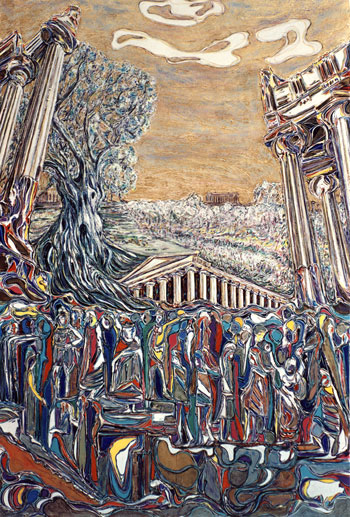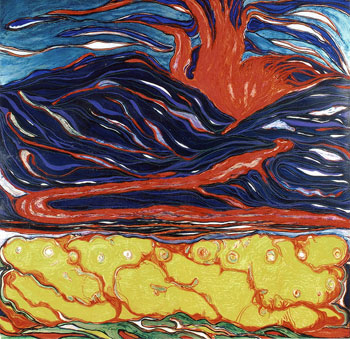Paths
Daniela Zumiani, 2010
 Pippo Borrello, 27 December 1970
Pippo Borrello, 27 December 1970
The painter Giuseppe Borrello receives the artistic impression from the sea, the Gulf of Naples, opposite which was born and lived. It’s a sea of strong colors, rich in contrasts, harmonies and disharmonies, definitely addictive for a delicate sensitivity which his; a sea which is difficult, as the artist himself had to say, now far from Naples: «it is not enough to know and love the sea. Indeed. This would lead to a painting of representation and I didn't want it. For years I had to curb the temptation to transfer onto the canvas furious wave on the rocks of Marechiaro. Then I realized...».
Classical studies, first, the meeting and the comparison with the Neapolitan artistic environment of the 1950s-60s of the twentieth century, then, are the basis of his pictorial formation. At the Accademy of Art in Naples Borrello met Emilio Notte and Guido Biasi;
He attended the 58. They are experimenters - and the young Borrello with them-international production-oriented first half of the century, but at the same time careful not to lose the inheritance of tradition. Passion looking for Armando De Stefano, who in the late 1950s, moves away from the realistic vein to an expressionistic style, attentive to the matter and tend to be abstract. Date back to the early 1960s some significant works of ours, almost all marine subjects, played on the contrast of colors and made with thick brushstrokes, with coloured filaments and clumps. Exemplary is the painting without title, where the large moon in the sky glows a typical mediterranean architecture: the sea cannot be seen, but it is the protagonist of the painting.
Already in these early trials, the artist's choice goes to the negation of depth, making his one of the cornerstones of the art of the twentieth century, namely the refusal to return the space, favouring at the same time the representation of time. At the same time he abandons the real fiction, Borrello chooses to give visibility to the unseen, to memory. The figures are limited to few signs, strands colour, evocative of the original form, distributed in large monochromatic backgrounds. In the professional "journey" of Borrello, early 1970s is a crucial date: it corresponds, in fact, upon his arrival in Verona, he was called to teach in the local art school. A reality that the Neapolitan artist, cheerful character, willing to confront joyfully change record immediately in his new pictorial compositions, many of which are on display in the prestigious veronese shield tunnel in 1974.
The surface of the paintings made during those years is divided into big plans, the colors used are limited mostly to whites, reds, blacks, among them sharply contrasted; solitary figures appear in the background (some will, in later years a leitmotif, as, for example, the horse Freedom divided): static, images are basically never defined, but deformed. In certain compositions can be felt though, for the first time, a latent interest in expressive effects, distinguishing feature throughout the production of the time to come.
 Vestigia, 1996 - Mixed technique on canvas - cm 100x150 - Popular Bank Foundation of Puglia and Basilicata (BA)
Vestigia, 1996 - Mixed technique on canvas - cm 100x150 - Popular Bank Foundation of Puglia and Basilicata (BA)
A choice that, perhaps, the vision of the Adige, whose sight was, evidently, linear a form other than that of the sea expanse. And the research on the expressiveness of line mark the next period's artistic journey. Borrello experiences, between eighty and ninety, the effect of intertwining among sweeping lines, break lines, in relation with strident colours or with each other in harmony. A study that makes it appear to the depiction of movement, with a view in particular to return the posturing of dancing bodies. Witness works such as Pas de deux, painting of the series exposed in Cork in 1985, as well as the many studies on the anatomy of horses in the race. Their shapes are now jumbled, disaggregated, deformed, then put back together again: nothing farther from the animal depicted statically in the 1970s.
Always from the 1980s Borrello engages with the portrait: his evidence are never trial, even if the choice is to evaluate realistically the effigies, so each character depicted must be perfectly recognisable. The artist manages, however, to seize wittily personality and the role of the subject depicted, usually, a protagonist of the show. Exemplary is the portrait of Eduardo De Filippo, whose face takes shape thanks to wavy line large flat bitmap backgrounds, solved with a limited range of colours: white, black, red. Jet-black eyes, partially in shadow, at first glance, but are worried about dress scene depicts Eduardo to a reality that is fiction, theatrical revealing that precisely through this kind of Visual oxymoron, because of the reserved look intriguing. The double portrait of Tebaldi, Regal figure mirrored in the singer, gives form to a paradox: the Queen of Opera communicates with her audience ignoring it.
Towards the 1990s Borrello made his triumphal entrance to black color, expression of a moment of reflection marked by nostalgia and pessimism. It captures in repeated marine compositions, in which appear dark, dense surfaces and materials. Of Waves, of 1986, Borrello himself said: "it is the work which best represents that returns to the idea I have of history and memory, because it has been made of matter, is dense it has the colour of memory '. And the "color" of which he speaks is actually a variety of colors: white, lumpy and often, purple, black matte gray filaments, the green in the foreground. Change the colors, in Ancestral secrets of 1987, but the underlying theme is always due to a painful depiction of the landscape of memory. The Gulf of Naples, painted in the 1960s, returned here, but out of focus, while in 1988, Nereids, are only black and white separated or maybe united by a solid United wavy line: this is, again, an evocation of the sea, almost absolute protagonist of paintings at the time, from Marine contact of 1987, to Game of waves of 1988.
 Eruption and brooms, 2006 - Mixed technique on canvas - cm 150x150 - Polytechnic of Singapore
Eruption and brooms, 2006 - Mixed technique on canvas - cm 150x150 - Polytechnic of Singapore
Evocations vaguely surreal, oneiric forms emerge in some evidence of this period; see, Blaze of 89, painting in which the lines melt, return the yellows, there are figures; or Stones to talk, work entitled emblematic played on contrasting image of blue and brown flat content drawn on white jagged shapes of the base surface.
Of 1991 is also Presences, intriguing portrait of Annamaria, companion of life and cultural experiences: half of his face is white and bright, half is attacked by an ominous brown shadow, a sort of threat that overshadows the fear of loss. Women of the South, in Naples, Annamaria is the presence of the beloved place in Verona. It captures in paintings of those years, a sort of black humor in readable, suffered and tormented figures, as in Posting. Even the painting surface dedicated to John Paul II, met in 1991, is divided diagonally into two parts by a line of the crucified: right, down, moves a crowd filaments, while in the top left, the Pope's profile, dissolves up to mingle with the white background.
The season of whites and blacks that happens back to color, which is also a return, as "visitor" at home. In 1994 Faraglioni documents a newfound joyfulness, an ode to classicism, whose statue is the symbol, as it is the largest ancient temple around which the crowd joins in Vestiges, of 1996. The lightness, the sunshine, the breath of the sea are the leitmotif of the paintings of Capri 1998, while in early 2000 meander cadences liberty. It captures into the waves dashed softly, in figures made with a sinuous line, the latter versions of themes of classicism. Years of frenetic activity, also linked to the need to give the impressions and emotions during his many trips to Germany, Austria, Holland, Brazil, America, Ireland.
In 2006 reappearing visual bells suggestions: Positano, People in Capri, again Faraglioni. The architectures and the coast are flat and neutral, surrounded by a rainbow of colours, that in contrast, makes emerge the silhouettes.
"Whims", finally, we call the works of the period between 2008 and today. "Whims" because Borrello condensate in a single composition emotions and impressions that he tried in different spaces and moments. You take Sail to Venice or Venice with sails, both of 2008: the diaphanous lagoon city designed in the background is submerged by garish sails; but the delicate Venetian light background don't succumbs in dialogue with the Mediterranean: rowdy brightness free interpretation of the Whims of the eighteenth century, works in which monuments of different cities lived together in a single painting.
In the wake of this fictional depiction are the compositions of the past two years, including the painting of refunds that places the artist prepares before arrival.
Paint a reality that you don't know helps not only to deal with it but also to make its own. The primitive, did we do today. So coming to Singapore and Carnival in Singapore of 2008 are pre-visions, images of an actual imagined to put the artist in condition to travel in time before in space: Visual confirmation that the journey continues and other goals are to be achieved.
Giuseppe Borrello travelled to Singapore a few months after these works, invited by the Republic Polytechnic.




